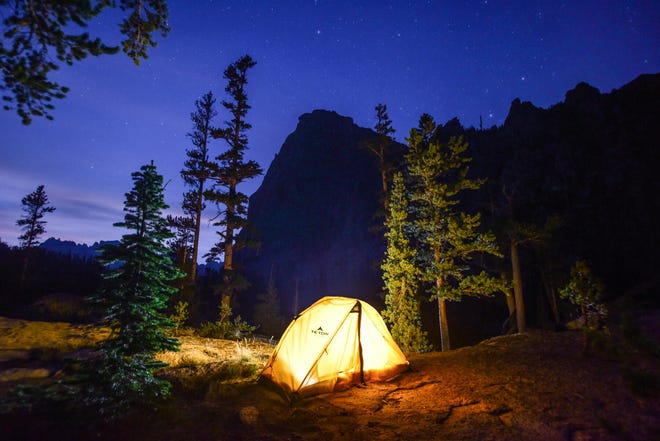For stargazers, the darkest skies provide the best entertainment. Planets, innumerable twinkling stars and bright meteors are good reasons to look up. But witnessing cosmic wonders has become sacred due to so many U.S. skies adversely affected by light pollution, making dark, clear evenings a challenge. So greater numbers of galaxy geeks are gravitating toward destinations where constellations are the brightest.
“Like seeing endangered animals, people want to see the rare night sky,” says Alan Dyer, an astronomy writer and photographer and producer of planetarium programs for the TELUS Spark Science Centre in Calgary, Alberta, in Canada. “Astrotourism is a growing part of the travel industry because people want to check amazing sights off their bucket list, like seeing the Northern Lights, a solar eclipse or the Milky Way. They’re on par with the scenic wonders on Earth.”
A good place to start when planning a stargazing trip is to consult the International Dark-Sky Association’s website for a listing of certified dark areas, including national parks. The International Dark Sky Places (IDSP) program is dedicated to preserving and protecting dark sites across the world. As of 2022, there are 195 certified IDSPs globally, with 60 in the U.S., including at least 17 national parks. Of course, visiting one of these areas on a clear night is important; so is the moon’s phase. A full moon creates its own version of light pollution, so try to time your trip a couple of days before, during and after a new moon to enhance your viewing odds.
While stars are guaranteed to be more visible in these certified dark sky places, even without a designation there are locations in the U.S. that put on brilliant night sky shows. Some of them are within driving distance of major U.S. destinations making them more accessible.
If astrotourism is on your agenda for 2022, this roundup of some the best starry escapes in the U.S., including locations with connections to the historic 1969 moon landing, will come in handy:
National Parks
Colorado
Located in the southwest corner of Colorado, Mesa Verde National Park features 600 ancient cliff dwellings and views of millions of nighttime stars and galaxies. In 2021, the park became the 100th certified International Dark Sky Park. Celestial sights can be seen from the park’s Morefield Campground and Far View Lodge, which also hosts ranger-led evening programs, including one on how Ancestral Pueblo people depended on nighttime skies for planting and harvesting of crops and tracking patterns of wildlife. Dark skies can also be admired from overlooks inside the park, including Geologic, Mancos Valley and the Montezuma Valley overlooks.
Utah
The Glen Canyon National Recreation Area on Lake Powell, straddling Arizona and Utah, is home to one of the world’s largest natural bridges, the arch-shaped Rainbow Bridge National Monument. The monument is a designated International Dark Sky Sanctuary, the first of its kind in the National Park Service, for the quality of its naturally dark night skies and the site’s cultural heritage. Stargazing and exploring the night sky is allowed almost anywhere in the park. Stargazing programs conducted by park rangers are also offered in the summer.
California
Yosemite National Park, about 170 miles east of San Francisco, offers views of the constellations in some of the area’s most popular stargazing spots, including Glacier Point, Sentinel Meadow, Olmstead Point, Washburn Point and Cook’s Meadow.
June through August amateur astronomers set up telescopes at Glacier Point on Saturdays. The park also has dedicated star programs such as Starry Night Skies Over Yosemite, a walking tour in Yosemite Valley to learn about the moon, the Milky Way galaxy, meteors, comets and more, and Glacier Point Starry Night Skies Over Yosemite, a bus tour to Glacier Point where visitors are treated to an astronomy program under the stars. Moonbow is a seasonal program to search for rainbowlike phenomenon that occur at night when the light from the moon refracts in water droplets from the park’s waterfalls.
Throughout the U.S.
Arizona:
In 2001, Flagstaff, Ariz., was recognized as the world’s first IDSP, and since then continues to impress visitors with its galaxy views. “Getting lost in the universe from Flagstaff’s clear dark window is a joy that doesn’t fade,” says Bonnie Stevens, executive director of the Flagstaff Dark Skies Coalition. Even before 2001, Flagstaff had impressive connections to space. Its lunar legacy includes serving as the training ground for Apollo astronauts such as Neil Armstrong and Edwin “Buzz” Aldrin who walked on the moon in 1969. Scientists transformed the northern Arizona landscape into a re-creation of the moon by using explosives to create a simulated lunar surface in the cinder fields near Sunset Crater. Artists also worked with scientists at the Lowell Observatory, which was established in Flagstaff in 1894, to create detailed lunar maps by observing the moon through Lowell telescopes.
Pro tip: From Sept. 22-24, Flagstaff, Ariz., will host its annual star party at Buffalo Park to celebrate the night sky.
The Lowell Observatory has various tours throughout the year as well as the Giovale Open Deck Observatory, which is a collection of six advanced telescopes that allow visitors to see the stars up close. There’s also the Wupatki National Monument’s parking
lot north of Flagstaff off Highway 89, a popular viewing spot because it has almost no
light pollution or obstructions to block moon sightings, and Buffalo Park, situated on McMillan Mesa northeast of downtown Flagstaff, with 215 acres to see the planets with the San Francisco Peaks and Mount Elden in the background.
Fun fact: The Lowell Observatory in Arizona is where the planet Pluto was discovered in 1930.
For more stars in Arizona, check out Mesa’s astronomy dinner cruises on Canyon Lake with the Dolly Steamboat, as well as several stargazing spots in Tucson, including Spencer’s Observatory next to the Cat Mountain Lodge, offering private star-viewing sessions featuring the Celestron 14-inch SCT telescope; the Mt. Lemmon SkyCenter, a
9,000-foot-tall formation located in Tucson’s Santa Catalina Mountains; the
for nightly stargazing programs and to learn about how the Apollo astronauts visited the observatory, before their moon landing, to view the moon through the McMath-Pierce Solar Telescope; or visit the Sky Bar, a solar-powered café with complimentary telescopes on its patio.
Pro tip: The Mt. Lemmon SkyCenter has the Southwest’s largest public telescope that allows visitors to see the rings of Saturn and spiral galaxies.
Idaho
Idaho is the location of the only International Dark Sky Reserve in the U.S. It spans more than 1,400 square miles from Ketchum/Sun Valley to Stanley, including lands in Blaine, Custer and Elmore counties and the Sawtooth National Recreation Area. It is the third-largest of 12 such reserves worldwide.
Idaho is also home to Craters of the Moon National Monument & Preserve, about 20 miles southwest of Arco. The Apollo astronauts explored the area’s lava landscape and learned the basics of volcanic geology in preparation for trips to the moon.
Pro tip: Visit Idaho’s International Dark Sky Reserve in August to view the Perseid meteor showers.
Midwest
Stargazing isn’t confined to Western states. The Eastern Iowa Observatory and Learning Center at Palisades-Dows Preserve near Cedar Rapids has two permanent telescopes and several portable telescopes.
The John Glenn Astronomy Park outside of Columbus, Ohio, is located under the dark skies of southeast Ohio’s Hocking Hills and offers guided stargazing programs on clear Friday and Saturday evenings March through November.
North Carolina
Cape Lookout National Seashore is a 56-mile strand of beaches that make up the coastal islands of eastern North Carolina, one of the world’s few remaining natural barrier island chains. In 2021, the site was certified as an International Dark Sky Park, the first Atlantic coastal dark sky place in the national park system to be named.


















